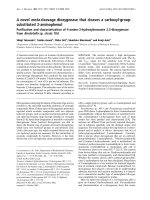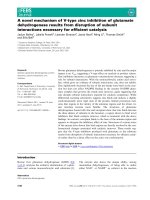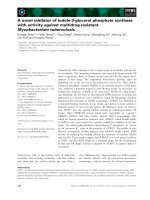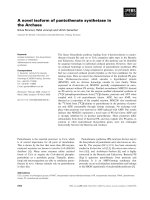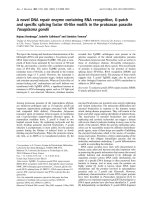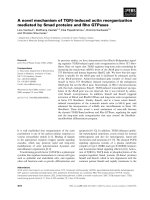Báo cáo y học: " A novel adenovirus of Western lowland gorillas (Gorilla gorilla gorilla)" ppt
Bạn đang xem bản rút gọn của tài liệu. Xem và tải ngay bản đầy đủ của tài liệu tại đây (990.47 KB, 8 trang )
SHOR T REPOR T Open Access
A novel adenovirus of Western lowland gorillas
(Gorilla gorilla gorilla)
Diana Wevers
1
, Fabian H Leendertz
2
, Nelly Scuda
1
, Christophe Boesch
3
, Martha M Robbins
3
, Josephine Head
3
,
Carsten Ludwig
4
, Joachim Kühn
5
, Bernhard Ehlers
1*
Abstract
Adenoviruses (AdV) broadly infect vertebrate hosts including a variety of primates. We identified a novel AdV in the
feces of captive gorillas by isolation in cell culture, electron microscopy and PCR. From the supernatants of infected
cultures we amplified DNA polymerase (DPOL), preterminal protein (pTP) and hexon gene sequences with generic
pan primate AdV PCR assays. The sequences in-between were amplified by long-distance PCRs of 2 - 10 kb length,
resulting in a final sequence of 15.6 kb. Phylogenetic analysis placed the novel gorilla AdV into a cluster of primate
AdVs belonging to the species Human adenovirus B (HAdV-B). Depending on the analyzed gene, its position within
the cluster was variable. To further elucidate its origin, feces samples of wild gorillas were analyzed. AdV hexon
sequences were detected which are indicative for three distinct and novel gorilla HAdV-B viruses, among them a
virus nearly identical to the novel AdV isolated from captive gorillas. This shows that the discovered virus is a
member of a group of HAdV-B viruses that naturally infect gorillas. The mixed phylogenetic clusters of gorilla,
chimpanzee, bonobo and human AdVs within the HAdV-B species indicate that host switches may have been a
component of the evolution of human and non-human primate HAdV-B viruses.
Findings
Adenoviruses are non-enveloped icosahedral double-
stranded DNA viruses that infect fish, amphibians, rep-
tiles, birds and mammals [1]. Human adenoviruses
(HAdV) are categorized into seven species (HAdV-A to
HAdV-G) [2]. Each species includes a distinct number of
serotypes [3]. In addition, intra-species shuffling of pen-
ton base, fiber and hexon genes by re combination has
been frequently observed [4-6]. Simian adenoviruses have
been discovered in monkeys and great apes [7-11]. They
are very similar to HAdV, and most of them can be
grouped into corresponding HAdV species or the newly
established species Simian adenovirus A (SAdV-A).
In 2008, a group of Western lowland gorillas (Gorilla
gorilla gorilla) suffered from prolonged diarrhea and
self-limiting respiratory disease in the Zoological gar-
dens of Münster, Germany. To isolate viral agents
potentially responsible for the symptoms, fecal samples
were suspended in phos phat e-buffered saline, sterile fil-
tered and cultured on MRC-5 cells and A549 c ells.
After eight days of culture, a cytopathogenic effect was
observed. The culture supernatant was examined by
electron microscopy, and virus-like structures w ere
detected their size and general structure being consis-
tent with that of adenoviruses (Additional Figure 1).
DNA was then extracted from culture supernatant
using the Qiagen tissue kit according to the manufac-
turer’ s instructions (Qiagen, Hilden, Germany), and a
generic primate adenovirus PCR was performed. For
this purpose, a nested set of degenerate and deoxyino-
sine-substituted (deg/dI) primers was designed, targeting
a highly conserved region of the DNA polymerase
(DPOL) gene of primate mastadenoviruses (Figure 1;
Table 1). PCR was performed in a total volume of 25 μl
with 0.2 μl AmpliTaq Gold (Applied B iosystems), 20
pmol of each primer, 200 μMdNTPs,2mMMgCl
2
,
and 5% DMSO. A T-Gradient thermocycler from Bio-
metra was used with the following cycling conditions:
95°C for 12 min, and 45 cycles of 95°C for 30 sec, 45°C
(1
st
round and 2
nd
round) for 30 sec and 72°C for
2 min, followed by a 15 min final extension step at
72°C. PCR products were purified using the Invisorb
DNA clean up kit according to the instructions of the
manufacturer (Invitek, Berlin, Germany), and directly
* Correspondence:
1
FG12 Division of Viral Infections, Robert Koch Institute, Berlin, Germany
Full list of author information is available at the end of the article
Wevers et al. Virology Journal 2010, 7:303
/>© 2010 Wevers et al; licensee BioMed Central Ltd. This is an Open Access article distributed under the terms of the Creative Commons
Attribution License ( which permits unrestricted use, distri bution, and repro duction in
any medium, provided the original work is properly cited.
sequenced with the Big Dye terminator cycle sequencing
kit (Applied Biosystems, Warrington, UK) on a 3 77
automated DNA sequencer (Applied Biosystems). In
BLAST analysis of GenBank, the sequence was most
closely related to chimpanzee AdVs and human AdVs of
the species HAdV-B. There was less similarity to the six
gorilla HAdV-B viruses (SAdV-27.2; SAdV-28.2; SAdV-
41.1;SAdV-41.2;SAdV-46;SAdV-47;Table2)recently
described [12]. Since the novel gorilla AdV was the
seventh HAdV-B of this host, it was named for the pur-
pose of this paper Gorilla gorilla adenovirus B7 (Ggor-
AdV-B7).
To acquire extended sequence information of Ggor-
AdV-B7, three additional nested PCR assays were
designed (Table 1) targeting the preterminal protein
(pTP) and two conserved regions at the 5’-and3’ -end
of the hexon gene (Figure 1). PCRs were performed as
describedabove,exceptthatelongationat72°Cwasfor
1 min. With each primer set products of the expected
size were obtained. BLAST analysis of their sequences
also revealed a HAdV-B-like virus (not shown). To
prove that the DPOL, pTP and hexon sequences origi-
nate from the same virus, we connected them with
long-distance (LD) PCRs (Figure 1) using the TaKaRa-
EX PCR system according to the instructions of the
manufacturer (Takara Bio Inc., Otsu, Japan). The LD
primer pairs are listed with their annealing temperatures
in Table 1. Three overlapping PCR products were gener-
ated and sequenced by primer walking. A final contigu-
ous sequence of 15637 bp was obtained spanning the
genes DPOL, pTP and 52 k, the genes encoding the
AdV proteins pIIIa, III (penton base), pVII, V, pX and
pVI, and the hexon gene of GgorAdV-B7 (Figure 1).
Since the AdV hexon gene is an important member of
the core gene set used for AdV classification [2,3,13,14],
we compared the avai lable partial hexon gene of Ggor-
AdV-B7 (2.7 kb) pair-wise with the corresponding
hexon sequences of the most closely related human and
chimpanzee HAdV-B viruses and all published gorilla
HAdV-B viruses. The highest identity percentages were
96.6% for SAdV-35.1 (chimpanzee AdV) and 96% for
HAdV-B21. The gorilla AdV SAdV-27.2, SAdV-28.2,
SAdV-41.1, SAdV-41.2, SAdV-46 and SAdV-47 revealed
only 87-91% identity. This closer relationship to HAdV-
B21 and SAdV-35.1 was restricted to the loop-encoding
regions 1 and 2 [15] as visible in an analysis with
the software SIMPLOT
(Figure 2). In pair-wise comparisons of DPOL and
pTP genes, GgorAdV-B7 was equally closely related to
chimpanzee and gorilla HAdV-B viruses (96-99.9%).
Figure 1 PCR amplification strategy. Above the ruler, the amplified part of the AdV genome is depi cted. Below, a schematic visualisation of
the positions of the degenerated consensus PCRs (red lines), the long-distance PCRs (black lines) and the resulting contiguous sequence (blue
line) is given. In the box, the hexon gene is magnified, and the positions of the hexon loops and the Hex-loop2 PCR (red line) are illustrated.
Wevers et al. Virology Journal 2010, 7:303
/>Page 2 of 8
However, the penton base gene of GgorAdV-B7 showed
a striking similarity (99.7%) only to that of SAdV-29
(chimpanzee AdV). Using the program mVISTA http://
genome.lbl.gov/vista/index.shtml, the near-perfect match
of the GgorAdV-B7 and SAdV-29 penton base genes
over the entire gene length is clearly visible (Figure 3).
With the PhyML plug-in 2.0. 1 of the Geneious Pro
5.0.4 software, phylogenetic trees were constructed on
the basis of hexon, DPOL, pTP and penton base gene
alignments (Figures 4). All published, completely
sequenced HAdV-B viruses were included. In the
hexon-based tree, GgorAdV-B7 clustered with HAdV-
B21, SAdV-35.1 (chimpanzee AdV) and SAdV-35.2
(bonobo AdV) (Figure 4a). DPOL and pTP analyses
placed GgorAdV-B7 into a tight cluster of gorilla and
chimpanzee AdVs (Figure 4b and 4c). In the tree
derived from the penton base, GgorAdV-B7 branched
separately, nearly at the same position as SAdV-29
(Figure 4d). With the MrBayes 2.0.2 plug-in (Geneious
Pro) or the Neighbor-Joining module of MacVector
10.6, trees with the same AdV clusters and similarly
supported topology were obtained (data not shown).
The remarkably close relatedness of GgorAdV-B7 to
chimpanzee AdVs (SAd V-29 and 35.1) prompted us to
investigate whether gorillas naturally host GgorAdV-B7.
For this purpose, we examined wild Western lowland
gorillas (Gorilla. g. gorilla) from Gabon and additional
captive gorillas. Fecal samples were collected from 19
individuals in a remote area with little human presence
in Loango National Park, G abon. They originated from
fresh nest sites or we re freshly found on gorilla paths
[16]. Samples were co llected using single-use gloves and
preserved by drying over silica. DNA was extracted fol-
lowing a previously described method [17]. In addition,
ten necropsy samples (spleen, liver, pancreas, lymph
node, tonsil, lung, kidney, urine) and one plasma sample
Table 1 Primers for amplification of DPOL, pTP and hexon gene sequences
Primer-set abbreviation Targeted gene Name of primer sequence 5’-3’ PCR length Annealing temp.
Degenerate primers
DPOL-cons DPOL 4431-s
$
GTnTwyGAyAThTGyGGhATGTAyGC
4428-as GAGGCTGTCCGTrTC(n/i)CCGTA
#
956 bp 45°C
4428-s CGGACGCCTCTGyTGGAC(n/i)AA
4429-as GGCCAGCACrAA(n/i)GArGC 650 bp 45°C
Hex-5’-cons Hexon 4515-s GTGGATGG(n/i)GA(r/i)GG(n/i)TACA
4515-as CGCACAACGTC(r/i)AA(n/i)AC(y/i)TC 536 bp 45°C
4516-s TGTAACATGAC(y/i)AA(r(i)GA(y/i)TGG
4516-as CAGGGCCCCCAT(n/i)GACA 381 bp 45°C
Hex3’-cons Hexon 4517-s CGCAATGGTC(n/i)TACATGCAC
4517-as CAGTGCCCGA(r/i)TA(k/i)GG(n/i)TT 340 bp 45°C
4518-s GCAGGACGC(y/i)TCGGAGTA
4518-as CACCC(k/i)GTT(r/i)TC(n/i)CC 230 bp 45°C
pTP-cons pTP 4521-s TGGCGACGT(n/i)GT(n/i)TACAG
4521-as CGGACT(y/i)(k/i)GA(r/i)CCTGAAA 260 bp 45°C
4522-s TACAGCCG(n/i)GTSTGGAAC
4522-as CTGAAAGAGAGTTC(n/i)ACAGAATCA 230 bp 45°C
Specific primers for long-distance PCR
pTP-DPOL-LD pTP, DPOL 4659-s TCGCATCTCCAACGACCT
4659-as GCATCCATGGTGAAGATTCC 2350 bp 60°C
Hex-LD Hexon 4618-s AGTTCGCTACACACTGGCTG
4618-as ATTGCGGTGATGATTGAATG 1354 bp 59°C
pTP-Hex-LD pTP, Hexon 4662-s CTCGGTATCGTTGACGGC
4662-as GATCAACGGGCACAAAGC 10044 bp 60°C
Primers specific for AdV species B
Hex-loop2 Hexon 5442s GAACAAGATACTTTAGCATGTGGAA
5442as GATTGAATGGATTAACATTGTCC 468 bp 55°C
Hexon 5443s TAGAAAATCACGGGGTGGAAGA
5443as GGCATCCAAAGACCATCTG 380 bp 55°C
$
s = sense, as = antisense
#
I = inosine
Wevers et al. Virology Journal 2010, 7:303
/>Page 3 of 8
were collected from four deceased captive gorillas in the
Zoological gardens of Berlin as well as six fecal sample s
from three captive gorillas in the Zoological gardens o f
Münster, Germany. To test for the presence of HAdV-B
viruses, we set up a nested PCR (PCR Hex-loop2; Table 1)
which targets flanking sequences of a hyper variable
region (loop 2) in the hexon gene (Figure 1) and ampli-
fies 380 bp. The primers were deduced from HAdV-B
sequences only and not degenerated. A total of 3 6 gor-
illa samples were screened. AdV DNA was only detecte d
in feces (5/19 wild gorilla samples and 4/6 captive gor-
illa samples). I n total, 9/25 fecal samples were PCR-
positive (36%), and the products sequenced. Most
importantly, a virus apparently identical to GgorAdV-
B7 was identified in a wild gorilla from Gabon. Three
additional HAdV-B viruses were also detected. Two
were without close similarities to any published AdV
sequence. The third one was nearly identical to the gor-
illa AdVs SAdV-27.2 and SAdV-47, which had been
originally isolated from captive individuals [12]. They
were tentatively named GgorAdV-B8, -B9 and -B10.
GgorAdV-B8 was detected in two fecal samples from
wild gorillas in Gabon and in one sample from Münster.
Its hexon sequence re vealed the highest pe rcentage of
identity (86.5%) to SAdV-21 (chimpanzee HAdV-B ).
GgorAdV-B9 was only amplified from captive gorillas
(two fecal samples from Münster) and showed 88% iden-
tity to SAdV-29 (chimpanzee HAdV-B). The GgorAdV-
B7 to -B10 Hex-loop2 sequences and closely related
sequences of published gorilla, chimpanzee, bonobo and
human HAdV-B viruses were subjected to phylogenetic
analysis as described above. In the tre e, the HAdV-B
viruses segregate int o several subclades with members of
two, three or four host species (human, chimpanzee,
bonobo and gorilla) (Figure 5). Thi s mixed clustering was
also observed upon analysis of the nearly complete hexon
gene (2.7 kb; Figure 4a) with GgorAdV-B7 only. It was
partially visible in the penton base tree (Figure 4d) and
Table 2 Adenoviruses, accession numbers and hosts
Adenovirus Abbreviation GenBank accession number Host Wild (Gabon) Captive
HAdV-B of this study
Gorilla gorilla adenovirus B7 GgorAdV-B7 HQ292614 Western lowland gorilla + +
Gorilla gorilla adenovirus B8 GgorAdV-B8 HQ292615 Western lowland gorilla + +
Gorilla gorilla adenovirus B9 GgorAdV-B9 HQ292616 Western lowland gorilla +
Gorilla gorilla adenovirus B10 GgorAdV-B10 HQ292617 Western lowland gorilla +
Published HAdV-B
Simian adenovirus 21 SAdV-21 AC000010 Chimpanzee +
Simian adenovirus 27.1 SAdV-27.1 FJ025909 Chimpanzee +
Simian adenovirus 27.2 SAdV-27.2 FJ025928 Gorilla +
Simian adenovirus 28.1 SAdV-28.1 FJ025914 Chimpanzee +
Simian adenovirus 28.2 SAdV-28.2 FJ025915 Gorilla +
Simian adenovirus 29 SAdV-29 FJ025916 Chimpanzee +
Simian adenovirus 32 SAdV-32 FJ025911 Chimpanzee +
Simian adenovirus 33 SAdV-33 JF025908 Chimpanzee +
Simian adenovirus 35.1 SAdV-35.1 FJ025912 Chimpanzee +
Simian adenovirus 35.2 SAdV-35.2 FJ025910 Bonobo +
Simian adenovirus 41.1 SAdV-41.1 FJ025913 Gorilla +
Simian adenovirus 41.2 SAdV-41.2 FJ025927 Gorilla +
Simian adenovirus 46 SAdV-46 FJ025930 Gorilla +
Simian adenovirus 47 SAdV-47 FJ025929 Gorilla +
Human adenovirus B3 HAdV-B3 DQ086466 Human
Human adenovirus B7 HAdV-B7 AC000018 Human
Human adenovirus B11 HAdV-B11 AY163756 Human
Human adenovirus B14 HAdV-B14 AY803294 Human
Human adenovirus B16 HAdV-B16 AY601636 Human
Human adenovirus B21 HAdV-B21 AY601633 Human
Human adenovirus B34 HAdV-B34 AY737797 Human
Human adenovirus B35 HAdV-B35 AY271307 Human
Human adenovirus B50 HAdV-B50 AY737798 Human
Wevers et al. Virology Journal 2010, 7:303
/>Page 4 of 8
Figure 2 Simplot analysis of the hexon gene. 2.8 kb of the GgorAdV-B7 hexon gene were compared t o the hexon genes of selected
chimpanzee (green and red line), gorilla (blue line) and human (yellow and grey line) AdVs. Below the plot, the analysis parameters are listed in
blue font. The hexon Loop 1 and Loop 2 regions are indicated at the bottom.
Figure 3 Pairwise sequence alignment of the penton base open reading frame. The penton base gene of GgorAdV-B7 was compared with
those of five gorilla-, three chimpanzee- and two human AdVs. The 50-100 percent sequence conservation is represented by the height of each
data point along the y axis. The chimpanzee AdV SAdV-29 is highlighted in grey designating the exceptionally high similarity to GgorAdV-B7.
Wevers et al. Virology Journal 2010, 7:303
/>Page 5 of 8
entirely absent from the DPOL and pTP trees (Figures 4b
and 4c). In addition, the phyl ogenetic position of a give n
primate AdV frequently differed, depending on the ana-
lyzed gene (compare Figures 4a to 4d).
Taken together, these observations cannot b e
explained by co-speciation. Rat her, they are in line with
recombination and host switching. Such events have
been previously discussed to be involved in the evolu-
tion of human AdV, because intra-species shuffling of
penton base, fiber and hexon genes has been frequently
observed [4-6]. In addition, a recombinant betwe en
viruses of t he sub-clades HAdV-B1 and HAdV-B2 has
been isolated from a captive chimpanzee [12]. Here, a
close similarity of GgorAdV-B7 to SAdV-29 (complete
sequence, excluding hexon loops) and to SAdV-35.1
(hexon loops) was observed (Figure 2). However, since
in the loop region the nucleic acid identity between
GgorAdV-B7 and SAdV-35.1 was well below 100%, it is
unlikely that t he existing AdVs are parent viruses in a
recent recombination event giving rise to GgorAdV-B7.
Rather, a more ancient one with subsequent genetic
drift may have been involved or recombination with an
unknown AdV, as suggested for HAdV-A18 [18].
Shuffling of genes by recombination between AdVs
that naturally infect different host species (e.g., great ape
and human AdVs) but under certain conditions co-
infectthesamehost,maybeanadditionalmechanism
by which AdVs exchange genetic i nformation. This
could occur in places where contacts between humans
and apes are frequent like in zoos and animal facilities.
In addition, people who are involved in hunting pri-
mates and preparation of bush meat [19] are at risk to
be infected. S o far, infections of humans with non-
human primate (NHP) AdVs have not been observed.
Nevertheless, antibodie s with specificity for chimpanzee
HAdV-C viruses have been detected in humans from
Sub-Saharan Africa and were significantly less frequent
in people from the United States of America and
Thailand [20]. In addition, the species HAdV-E com-
prises only one human serotype but more than 12 great
ape serotypes. Therefore, the human HAdV-E was
thought to be the result of a zoonotic trans mission from
chimpanzees to humans [21]. The gorilla AdV described
in the present study (GgorAdV-B7) is highly similar to
chimpanzee AdVs. Thus, a transmission event between
chimpanzees and gorillas was possibly involved which is
Figure 4 Phylogenetic analysis. The Hexon (A), DPOL (B), pTP (C) and penton (D) sequences of GgorAdV-B 7 and those of published NHP and
human HAdV-B viruses were aligned and subjected to phylogenetic analysis. Human, chimpanzee, bonobo and gorilla AdVs are in black, blue,
green and red font, respectively. AdVs discovered in this study are marked with black dots.
Wevers et al. Virology Journal 2010, 7:303
/>Page 6 of 8
further indication for the potential of AdVs to jump
between closely related hosts.
Very little is known about the pathogenic properties of
NHP-AdV. GgorAdV-B7 was originally discovered in a
group of gorillas suffering from prolonged diarrhea and
self-limiting respiratory infection. Since human species
B AdV have been linked to respiratory diseases [22-24],
an etiological association of GgorAdV-B7 with the
observed respiratory symptoms is possible. However,
recent studies reported the frequent shedding of AdVs
in the feces of healthy captive chimpanzees and gorillas
[12,25]. Therefore, further investigations are needed.
Knowledge about the spectrum of AdV in wild great
apes in general [25] is very limited. Specifically from
wildgorillas,noinformationhasbeenpublished.
Although examining only a small set of samples, our
findings show that AdV inf ecting captive gorillas can
readily be found in wild animals (GgorAdV-B7; Ggor-
AdV-B8). This is a good example of how humans may
be brought into contact with new pathogens, not only
locally through bushmeat hunting in regions where
NHP live naturally, but also in other regions of the
world where NHP are housed in zoos.
The high variety of known and novel HAdV-B viruses in
great apes calls for larger studies to understand the diver-
sity of AdVs currently circulating in African NHP as well
as in local human populations. It is justified to assume that
such studies will improve our insight into t he zoonotic
potential of adenoviruses a nd possibly a nswer the intri-
guing question whether AdVs of non-human primates
have already contributed to the human “adeno-virosphere”.
Accession numbers
The sequences reported in this study were deposited in
GenBank under the accession numbers listed in Table 2.
Additional material
Additional Figure 1: Negative stain electron micrograph of
adenovirus-like particles isolated from a fecal sample of a captive
gorilla. Negatively stained with 1% uranyl acetate. Virus particles are 70-
90 nm in diameter with an icosahedral shape. Scale bar = 200 nm.
Acknowledgements
We thank Michael Laue for electron microscopic analysis. The technical
assistance of Sonja Liebmann and Cornelia Walter is kindly acknowledged.
Figure 5 Phylogenetic analysis of the hexon loop 2 region. For details, see legend of Figure 4.
Wevers et al. Virology Journal 2010, 7:303
/>Page 7 of 8
We thank the Agence Nationale des Parcs Nationaux (ANPN) and the Centre
National de la Recherche Scientifique et Technique (CENAREST) of Gabon for
permission to conduct research in Loango National Park. We also thank the
Société pour la Conservation et le Développement (SCD) and Wildlife
Conservation Society (WCS) for financial and logistical support. For sample
collection from wild gorilla, we thank L. Rabanal, L. Mackaga, E. R. Guizard, N.
Tagg, B. Graw, E. Fairet, M. Gregoire, L. Rankin and the other field assistants
of the Loango Ape project. For DNA extraction and identification of
individual samples from wild gorilla we thank M. Arandjelovic and L. Vigilant
from the Max-Planck-Institute for Evolutionary Anthropology, Leipzig.
Author details
1
FG12 Division of Viral Infections, Robert Koch Institute, Berlin, Germany.
2
Junior research group “Emerging Zoonoses”, Robert Koch Institute, Berlin,
Germany.
3
Department of Primatology, Max-Planck-Institute for Evolutionary
Anthropology, Leipzig, Germany.
4
Westfälischer Zoolog ischer Garten Münster
GmbH, Münster, Germany.
5
Institute of Medical Microbiology, Clinical
Virology, University of Münster, Münster, Germany.
Authors’ contributions
DW and JK performed the cell culture experiments. DW, NS, JK and JH
performed the molecular genetic studies. FHL, CB and MMR coordinated
field work and sample collection. JH and CL sampled gorilla feces. DW, NS,
JK, FHL and BE conceived of the study, and participated in its design and
coordination. DW, FHL, CB, JK and BE drafted the manuscript. All authors
read and approved the final manuscript.
Competing interests
The authors declare that they have no competing interests.
Received: 1 September 2010 Accepted: 5 November 2010
Published: 5 November 2010
References
1. Davison AJ, Benko M, Harrach B: Genetic content and evolution of
adenoviruses. J Gen Virol 2003, 84:2895-2908.
2. Benkö M, Harrach B, Both G, Russel W, Adair BM, Adam E, de Jong JC,
Hess M, Johnson M, Kajon A, et al: Family Adenoviridae. In Virus Taxonomy:
VIIIth Report of the International Committee on Taxonomy of Viruses. Edited
by: Fauquet CM, Mayo MA, Maniloff J, Desselberger U, Ball LA. Elsevier;
2005:213-228.
3. Bailey A, Mautner V: Phylogenetic relationships among adenovirus
serotypes. Virology 1994, 205:438-452.
4. Lukashev AN, Ivanova OE, Eremeeva TP, Iggo RD: Evidence of frequent
recombination among human adenoviruses. Journal of General Virology
2008, 89:380-388.
5. Robinson CM, Rajaiya J, Walsh MP, Seto D, Dyer DW, Jones MS, Chodosh J:
Computational analysis of human adenovirus type 22 provides evidence
for recombination among species D human adenoviruses in the penton
base gene. Journal of Virology 2009, 83:8980-8985.
6. Walsh MP, Chintakuntlawar A, Robinson CM, Madisch I, Harrach B,
Hudson NR, Schnurr D, Heim A, Chodosh J, Seto D, Jones MS: Evidence of
molecular evolution driven by recombination events influencing tropism
in a novel human adenovirus that causes epidemic keratoconjunctivitis.
PLoS One 2009, 4.
7. Kovacs G, Harrach B, Zakhartchouk AN, Davison AJ: Complete genome
sequence of simian adenovirus 1: An Old World monkey adenovirus
with two fiber genes. Journal of General Virology 2005, 86:1681-1686.
8. Basnight M Jr, Rogers NG, Gibbs CJ Jr, Gajdusek DC: Characterization of
four new adenovirus serotypes isolated from chimpanzee tissue
explants. American Journal of Epidemiology 1971, 94:166-171.
9. Kovacs GM, Davison AJ, Zakhartchouk AN, Harrach B: Analysis of the first
complete genome sequence of an Old World monkey adenovirus
reveals a lineage distinct from the six human adenovirus species. Journal
of General Virology 2004, 85:2799-2807.
10. Bányai K, Esona MD, Liu A, Wang Y, Tu X, Jiang B: Molecular detection of
novel adenoviruses in fecal specimens of captive monkeys with diarrhea
in China. Veterinary Microbiology 2010, 142:416-419.
11. Kidd AH, Garwicz D, Oberg M: Human and simian adenoviruses:
Phylogenetic inferences from analysis of VA RNA genes. Virology 1995,
207:32-45.
12. Roy S, Vandenberghe LH, Kryazhimskiy S, Grant R, Calcedo R, Yuan X,
Keough M, Sandhu A, Wang Q, Medina-Jaszek CA, et al: Isolation and
characterization of adenoviruses persistently shed from the
gastrointestinal tract of non-human primates. PLoS Pathogens 2009, 5.
13. Casas I, Avellon A, Mosquera M, Jabado O, Echevarria JE, Campos RH,
Rewers M, Perez-Brena P, Lipkin WI, Palacios G: Molecular identification of
adenoviruses in clinical samples by analyzing a partial hexon genomic
region. J Clin Microbiol 2005, 43:6176-6182.
14. Crawford-Miksza LK, Schnurr DP:
Adenovirus serotype evolution is driven
by illegitimate recombination in the hypervariable regions of the hexon
protein. Virology 1996, 224:357-367.
15. Torres S, Chodosh J, Seto D, Jones MS: The revolution in viral genomics as
exemplified by the bioinformatic analysis of human adenoviruses. Viruses
2010, 2:1367-1381.
16. Arandjelovic M, Head J, Kühl H, Boesch C, Robbins MM, Maisels F, Vigilant L:
Effective non-invasive genetic monitoring of multiple wild western
gorilla groups. Biological Conservation 2010, 143:1780-1791.
17. Nsubuga AM, Robbins MM, Roeder AD, Morin PA, Boesch C, Vigilant L:
Factors affecting the amount of genomic DNA extracted from ape
faeces and the identification of an improved sample storage method.
Mol Ecol 2004, 13:2089-2094.
18. Walsh MP, Seto J, Tirado D, Chodosh J, Schnurr D, Seto D, Jones MS:
Computational analysis of human adenovirus serotype 18. Virology 2010,
404:284-292.
19. Bennett EL, Blencowe E, Brandon K, Brown D, Burn RW, Cowlishaw G,
Davies G, Dublin H, Fa JE, Milner-Gulland EJ, et al: Hunting for consensus:
Reconciling bushmeat harvest, conservation, and development policy in
West and Central Africa. Conservation Biology 2007, 21:884-887.
20. Xiang Z, Li Y, Cun A, Yang W, Ellenberg S, Switzer WM, Kalish ML, Ertl HCJ:
Chimpanzee adenovirus antibodies in humans, sub-Saharan Africa.
Emerging Infectious Diseases 2006, 12:1596-1599.
21. Purkayastha A, Ditty SE, Su J, McGraw J, Hadfield TL, Tibbetts C, Seto D:
Genomic and bioinformatics analysis of HAdV-4, a human adenovirus
causing acute respiratory disease: Implications for gene therapy and
vaccine vector development. Journal of Virology 2005, 79:2559-2572.
22. Schmitz H, Wigand R, Heinrich W: Worldwide epidemiology of human
adenovirus infections. American Journal of Epidemiology 1983, 117 :455-466.
23. Russell WC: Adenoviruses. In Topley and Wilson’s Virology Edited by: Mahy
BWJ, Ter Meulen V, Hodder Arnold , 10 2005, 439-443.
24. Gray GC, Callahan JD, Hawksworth AW, Fisher CA, Gaydos JC: Respiratory
diseases among U.S. Military personnel: Countering emerging threats.
Emerging Infectious Diseases 1999, 5:379-387.
25. Tong S, Singh J, Ruone S, Humphrey C, Yip CCY, Lau SKP, Anderson LJ,
Kaur T: Short report: Identification of adenoviruses in fecal specimens
from wild chimpanzees (Pan trogylodytes schweinfurthii) in Western
Tanzania. American Journal of Tropical Medicine and Hygiene 2010,
82:967-970.
doi:10.1186/1743-422X-7-303
Cite this article as: Wevers et al.: A novel adenovirus of Western
lowland gorillas (Gorilla gorilla gorilla). Virology Journal 2010 7:303.
Submit your next manuscript to BioMed Central
and take full advantage of:
• Convenient online submission
• Thorough peer review
• No space constraints or color figure charges
• Immediate publication on acceptance
• Inclusion in PubMed, CAS, Scopus and Google Scholar
• Research which is freely available for redistribution
Submit your manuscript at
www.biomedcentral.com/submit
Wevers et al. Virology Journal 2010, 7:303
/>Page 8 of 8

